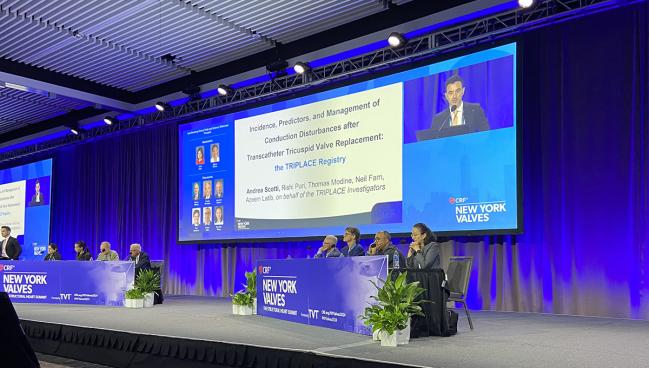AV Block Common After Transcatheter Tricuspid Valve Replacement for TR
The findings highlight the need for EP involvement in heart team discussions, and for ongoing innovation, as TTVR gathers steam.

NEW YORK, NY—High-grade atrioventricular (AV) block occurs within 1 month for roughly one in seven patients who undergo transcatheter tricuspid valve replacement (TTVR), according to new results from the TRIPLACE registry.
Overall, 12.4% of TTVR patients needed a permanent pacemaker to treat the conduction disturbance—a number that would have been higher except that three patients with high-grade AV block died before the pacemaker could be implanted, say investigators.
The vast majority of conduction disturbances occurred within the first week of the procedure.
The findings, which were presented this week at New York Valves 2024, previously known as the TVT meeting, suggest that these patients should be closely monitored after TTVR; this is particularly the case for those at higher risk for conduction disturbances, such as those with preexisting left bundle branch block (LBBB).
“What we found was that 15%, more or less, developed high-grade AV block,” lead investigator Andrea Scotti, MD (Montefiore Medical Center, New York, NY), told TCTMD. “The first week was the ‘hot period’ for these conduction disturbances, but you know, especially when we’re in this early phase of TTVR, even if 2 weeks may be enough, we recommend monitoring these patients up to 1 month with cardiac monitoring devices.”
If you're making the patient better and the downside is you end up with a pacemaker, then that's not the worst thing in the world. Laurence Epstein
Laurence Epstein, MD (Northwell Health/Zucker School of Medicine at Hofstra, Manhasset, NY), an electrophysiologist, said the anatomy of the heart’s right side makes the placement of a device ripe for conduction disturbances.
“Here, the AV node and His-Purkinje system is more superficial [than on the left side],” he told TCTMD. “The relationship to the triangle of Koch where the conduction system sits and the leaflet insertion on the septal side of the tricuspid valve, you’re right there. Anything that’s going to anchor in that region has the real potential to put pressure directly on the conduction system.”
Surgeons, he noted, use anchoring rings that are more C-shaped as opposed to a 360-degree ring, with the opening placed to avoid damaging the conduction system. As TTVR technology develops, the challenge will be to develop a device that takes radial pressure away from this region to reduce the risk of AV block.
That said, the need for a new pacemaker might be worth the trade-off for patients with severe TR, a group living with heart failure and very poor quality of life, said Epstein.
“It’s always an individualized decision and a risk-benefit analysis,” he said “But, again, if you're making the patient better and the downside is you end up with a pacemaker, then that's not the worst thing in the world.”
LBBB Predicts Complete AV Block
In early 2024, the US Food and Drug Administration approved the Evoque TTVR system (Edwards Lifesciences) for the treatment of tricuspid regurgitation based on the results of the TRISCEND II study. While it’s the lone device approved in the US and Europe, other TTVR systems are currently being developed and tested, including Intrepid (Medtronic), NaviGate (NaviGate Cardiac Structures), Cardiovalve (Cardiovalve), and LuX-Valve (Ningbo Jenscare Biotechnology).
Speaking during the late-breaking clinical trial session, Scotti noted that 14.7% of patients in TRISCEND II required a permanent pacemaker. However, if patients with a permanent pacemaker at baseline were excluded, the need for permanent pacing increased to 23%, which is quite significant, he said.
The purpose of the new analysis was to tease out the timing, predictors, and management of conduction-system disorders after TTVR based on data from the TRIPLACE registry. This registry excludes patients who are actively involved in clinical trials, but includes patients treated with a variety of TTVR devices for first-in-human, compassionate use, or commercial cases not part of an ongoing study. Given that many devices are still investigational, the TRIPLACE registry was designed to be anonymous, with investigators not collecting any information on the device type or valve size.
In total, 129 patients (mean age 74 years; 71% women) were included in the study. Scotti said the study population represented a “classic” group of patients with severe TR in need of an intervention. Nearly 90% had atrial fibrillation at baseline, 5% had first-degree AV block, 33% had right bundle branch block (RBBB), and 7% had LBBB, left anterior fascicular block (LAFB), or left posterior fascicular block (LPFB).
At 1 month, 22% of patients developed new RBBB and 15% had high-degree AV block in need of permanent pacing. Of those 19 patients with AV block, three died before the they could be treated with a permanent pacemaker (two because of AV block and one because of sepsis). In terms of the timing, 89% of high-degree AV block cases occurred in the first week.
The lone significant ECG predictor of high-degree AV block was baseline LBBB or LAFB/LPFB (OR 6.9; 95% CI 1.2-36.4). Scotti said the confidence intervals are wide given the small number of patients in the registry at present, but that they are continuing to enroll patients and will analyze the data again. Nonetheless, their analysis showed that four out of nine patients with baseline LBBB or LAFB/LPFB will need a permanent pacemaker because of high-degree AV block.
“This makes sense,” said Scotti. “If the left side is impaired and we’re damaging the right side, of course we’re going to have a complete AV block.”
In terms of future designs to address the risk, Scotti said the anchoring system plays an important role in terms of the interaction with the conduction system. If the bioprosthesis expands using radial force, it’s possible the risk will be higher than another valve anchored by a different mechanism. Right now, though, the field is still too new to truly identify the best way to mitigate the rates of AV block seen so far, he said.
As for the clinical consequences of permanent pacing, Scotti said it’s too early to know.
“We have been doing TAVR now for many years and only now are we seeing that a pacemaker might be important for patients with a low ejection fraction,” said Scotti. “On the right side, I think it's premature to answer this question. We will see with longer follow-up.”
EP Involvement
Generally speaking, Epstein said the transcatheter valve field, including the heart team back at hospitals, needs greater involvement from electrophysiologists, and not just for patients with tricuspid valve disease.
There are well known conduction issues related to TAVI, for example, as well as considerations for patients with functional mitral regurgitation, such as the possibility of treating atrial fibrillation or implanting a cardiac resynchronization therapy device before replacing or repairing the valve percutaneously.
“Clearly, these are things we should be involved with,” said Epstein. “In the tricuspid space, where many of the patients with TR have a preexisting [pacemaker or implantable cardioverter-defibrillator] lead, how do you manage those leads? There are downsides of jailing leads, [including] the long-term effects of making it unextractable if they get infected or creating a fulcrum on the lead that's going to lead to long-term lead failure.”
Just last month, Epstein, along with Rebecca Hahn, MD (NewYork-Presbyterian/Columbia University Irving Medical Center, New York, NY), and other members of the Heart Valve Collaboratory, published a state-of-the-art review of managing implanted cardiac electronic devices in patients with severe TR.
“It’s important to have the EP involved in these discussions,” said Epstein.
Michael O’Riordan is the Managing Editor for TCTMD. He completed his undergraduate degrees at Queen’s University in Kingston, ON, and…
Read Full BioSources
Scotti A, Puri R, Modine T, et al. Incidence, predictors, and management of conduction disturbances after transcatheter tricuspid valve replacement. Presented at: New York Valves 2024. June 6, 2024. New York, NY.
Disclosures
- Scotti reports consulting fees/honoraria/speaking bureau payments from NeoChord and consulting for Edwards Lifesciences.
- Epstein reports consulting fees/honoraria/speaking bureau payments from Boston Scientific, Philips, Medtronic, and Abbott.





Comments